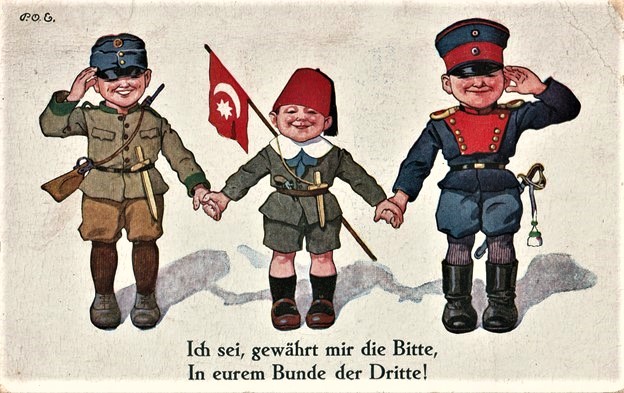Bob Teevan
One and One and One is Three
You may not believe it, but a bit of thought goes into my posts, although, nowhere near as much thought as may go into the design and publishing of postcards.

The card above is an example. It is one published in Germany. The artist is unknown, and even the initials in the top left may potentially be a signature, they too are unknown. The address side has a logo of what may be a publisher’s, but that too is unknown. The reverse is marked ‘Kriespostkarte No. 39’ (War Postcard No. 39) and while I have seen for sale a card No. 62 having the same initials and markings, the German seller of this card detailed the card as unbranded.
The image is a well-drawn illustration of three children standing hand in hand. The boys are dressed in military uniforms, and each represents a nation involved in World War One. The use of children in military uniforms is not unusual. There are many cards depicting the nations of the Allied armies. This, however, is the first card I have seen that depicts the nations of the Central Powers, although this by no means makes it a scarce card.
The nation of the boy in the center is easily established as he is wearing a red fez and carries the flag of Turkey. It may be that the child on the right represents Bulgaria. The red band on his military cap was a standard Bulgarian uniform feature. The child on the left is from Austria-Hungary. At first glance, this child could be mistaken as German, although concerns regarding his cap would suggest he wear a pickelhaube. This concern prompted a check of the uniforms worn by the Austria-Hungarian troops and both the shape and color of this cap are an exact match.
This German patriotic card was mailed by a member of the 7th Regiment of the 5th Bavarian Infantry Division on 8th April 1916. It carries decent markings in respect to the Field post and Administration unit. The handwriting and the fact that it is written in German limits further investigation.
The 5th Bavarian Reserve Division fought in the opening phases of the war in the Battle of the Frontiers. Then in the Race to the Sea, including the Battle of Arras in October 1914. It remained in the trench lines in Flanders until 1916, when it entered the Battle of the Somme in August. The unit did see further actions although after the date on the card.
What is clever about a patriotic German card featuring children in national uniforms? It may be the title!
The card is titled Ich sei, gewährt mir die Bitte, In eurem Bunde der Dritte! (I be, grant me the request, The third in your league!) When I saw the translation, I thought that it was a bit disjointed and, dare I say, typical of online translations. Before I set about trying to adjust the translation to something closer to expectation, a simple [string of text] search yielded an exact match which led to a 1799 ballad named Die Burgshaft (The Pledge or sometimes The Hostage) by the German poet Frederick Schiller.
This is one of the most famous of all Schiller’s ballads. German speakers of earlier generations learned it by heart as schoolchildren and recited it until their dying day. It is a Teutonic equivalent of Browning’s (much shorter) How They Brought the Good News From Ghent To Aix.
As for the backstory of the image. It is likely the card was published after October 1915. At the outbreak of World War One both Germany and Austria-Hungary were bound by an alliance dating from 1879. The Ottoman Empire (Turkey) and Bulgaria did not join until after World War I had begun, even though the Ottoman Empire had retained close relations with both Germany and Austria-Hungary since the beginning of the 20th century.
The Ottoman Empire announced its backing of the Central Powers on October 29, 1914; however Bulgaria did not join until October 14, 1915. It may be this card depicts Bulgaria joining Austria-Hungary and Turkey. Of course, this is in no way certain.
* * *
Now that we know the expressed thought that an artist simply invented the title was not the case, it transpires that this was the final lines of a ballad taught to young German nationals. I personally think that’s clever.
Interesting that the Turk is depicted as a boy, as the Ottoman Empire had been frequently referred to as the “sick man of Europe” since around the time the Crimean War was contested.